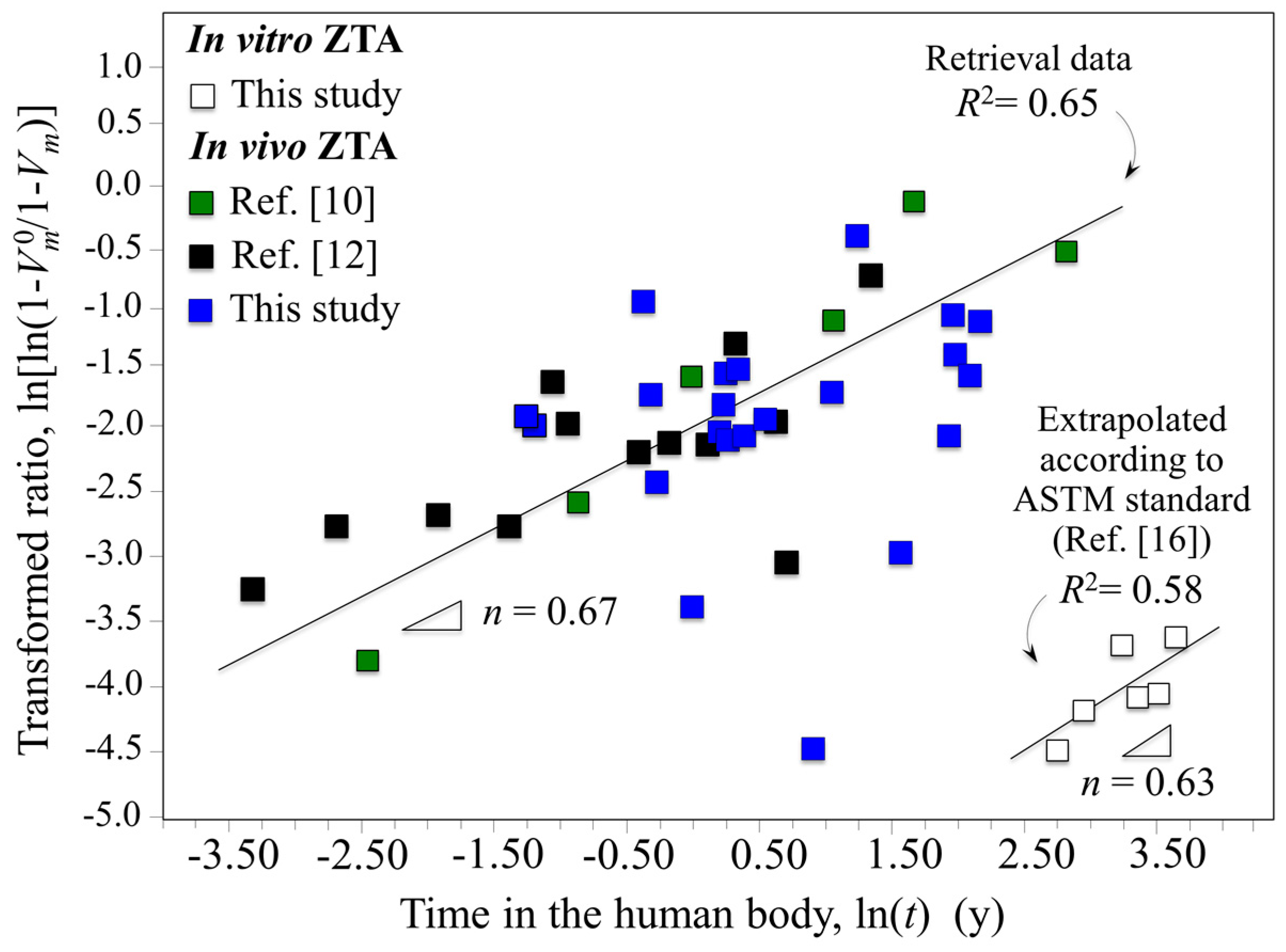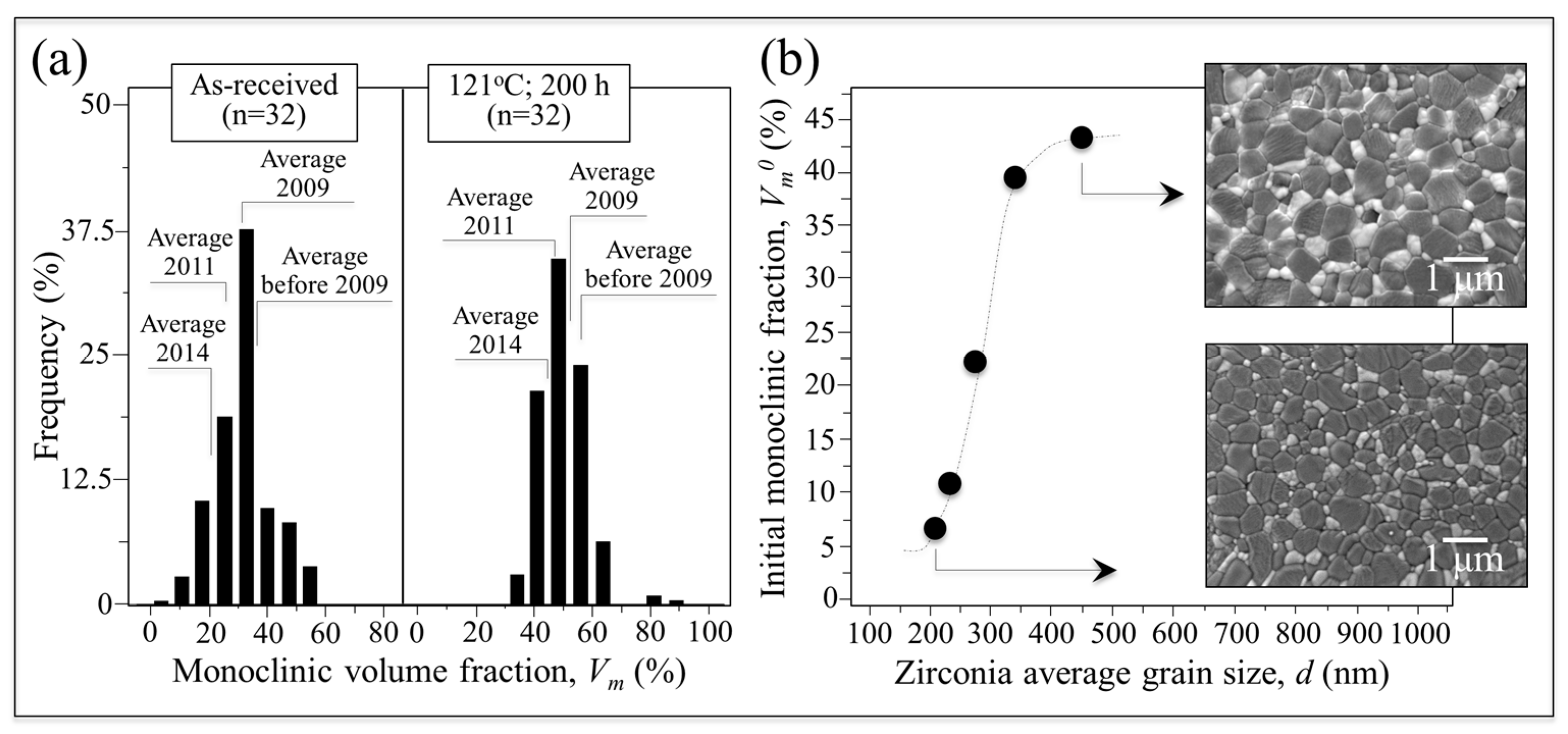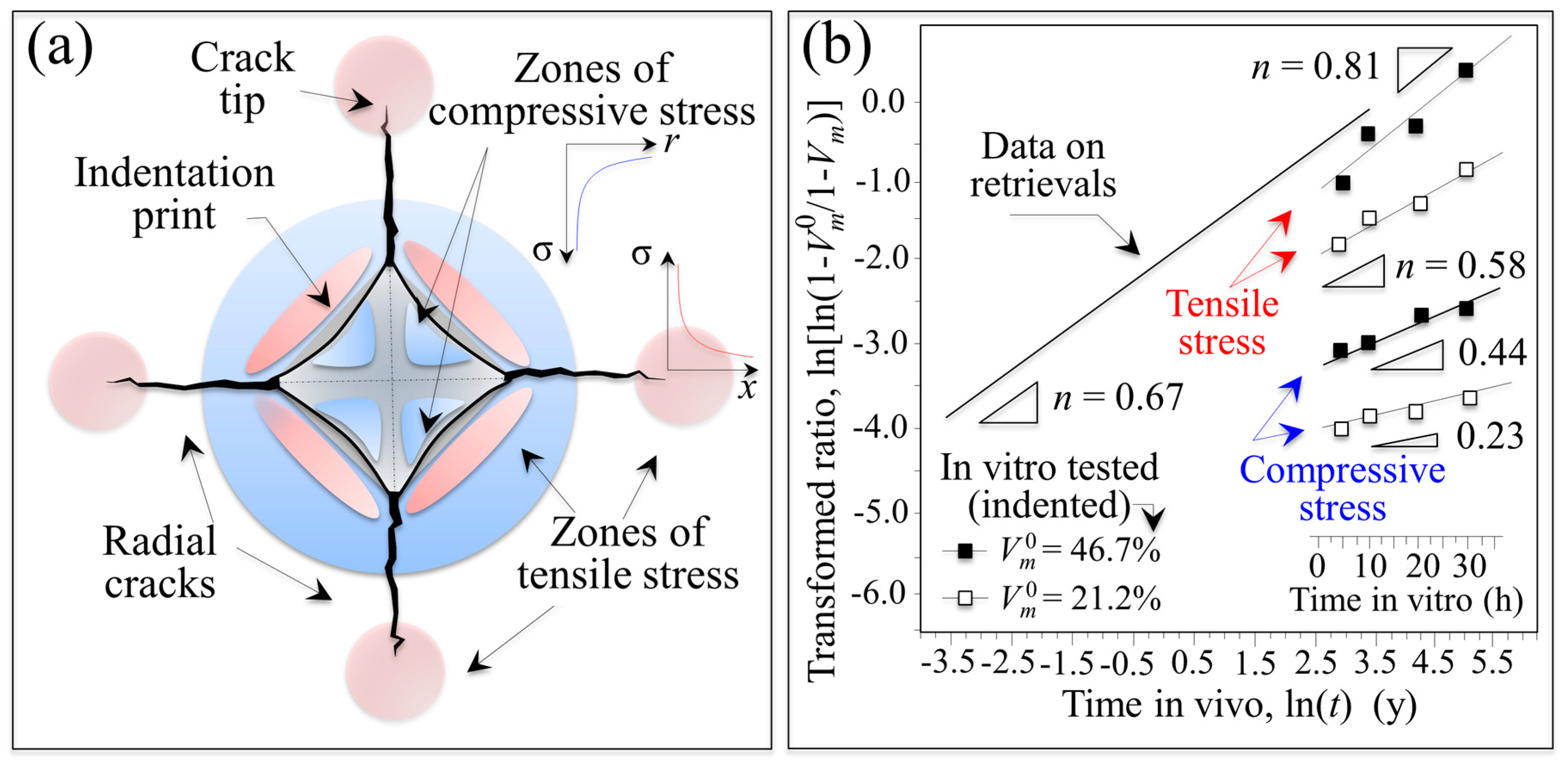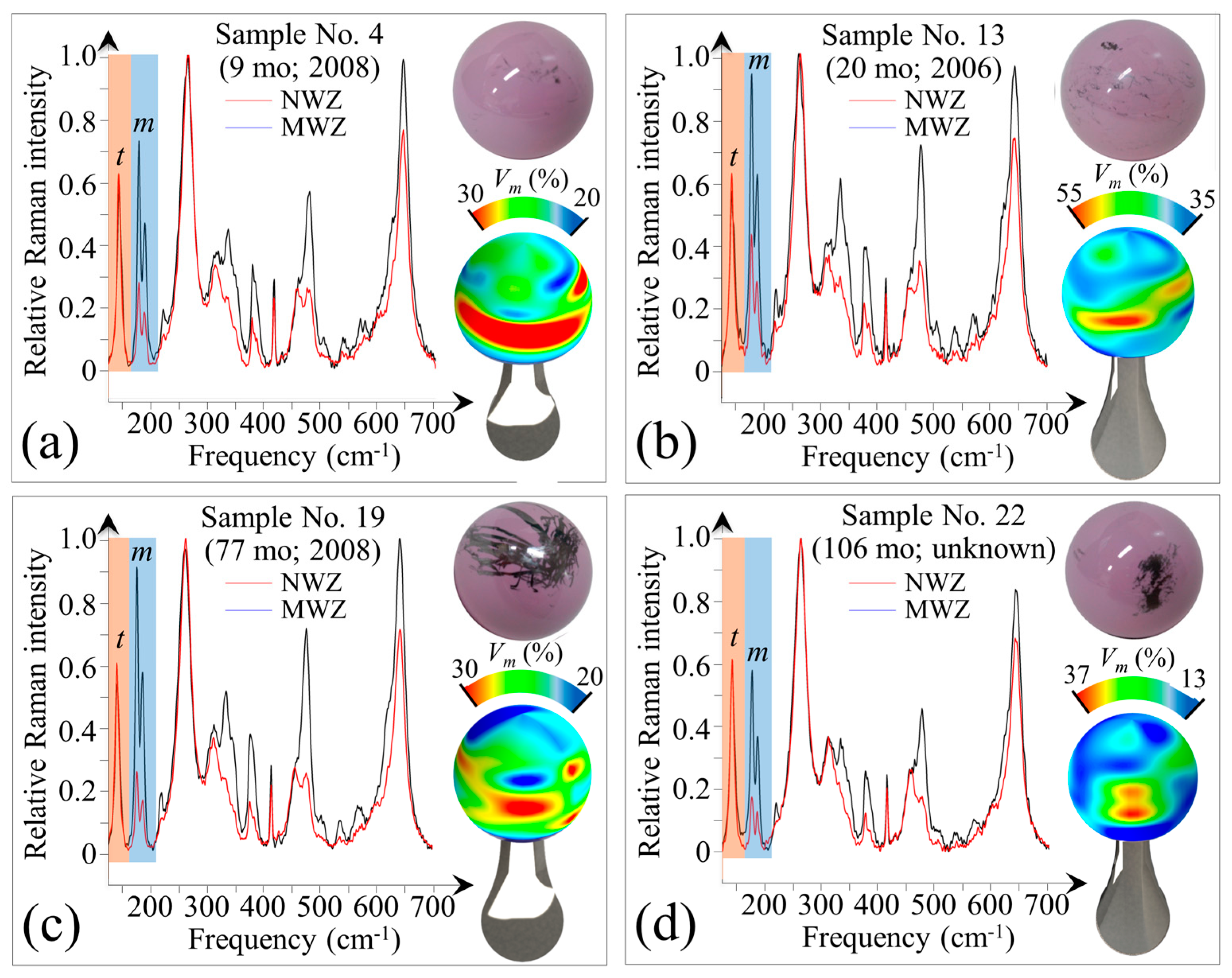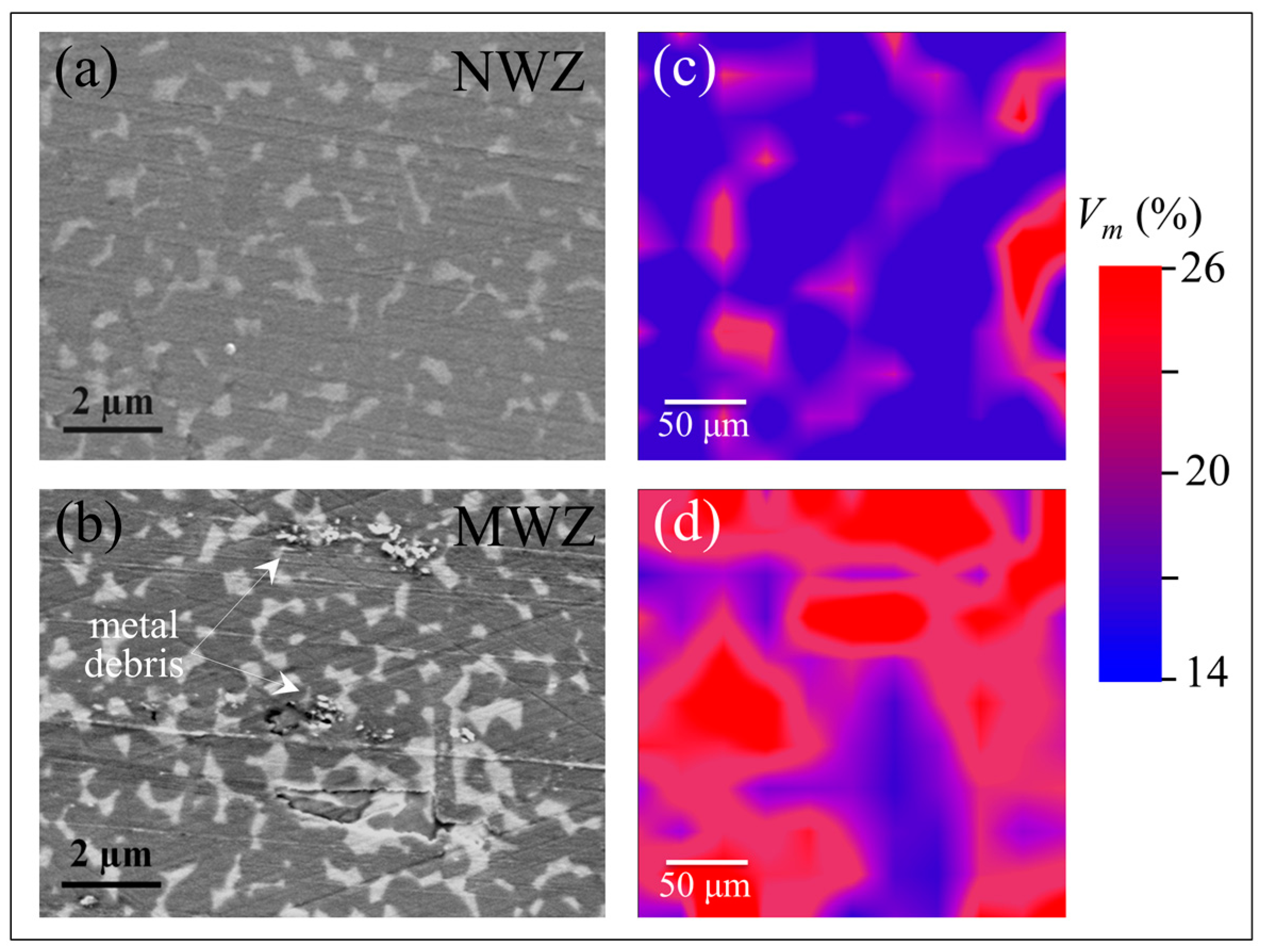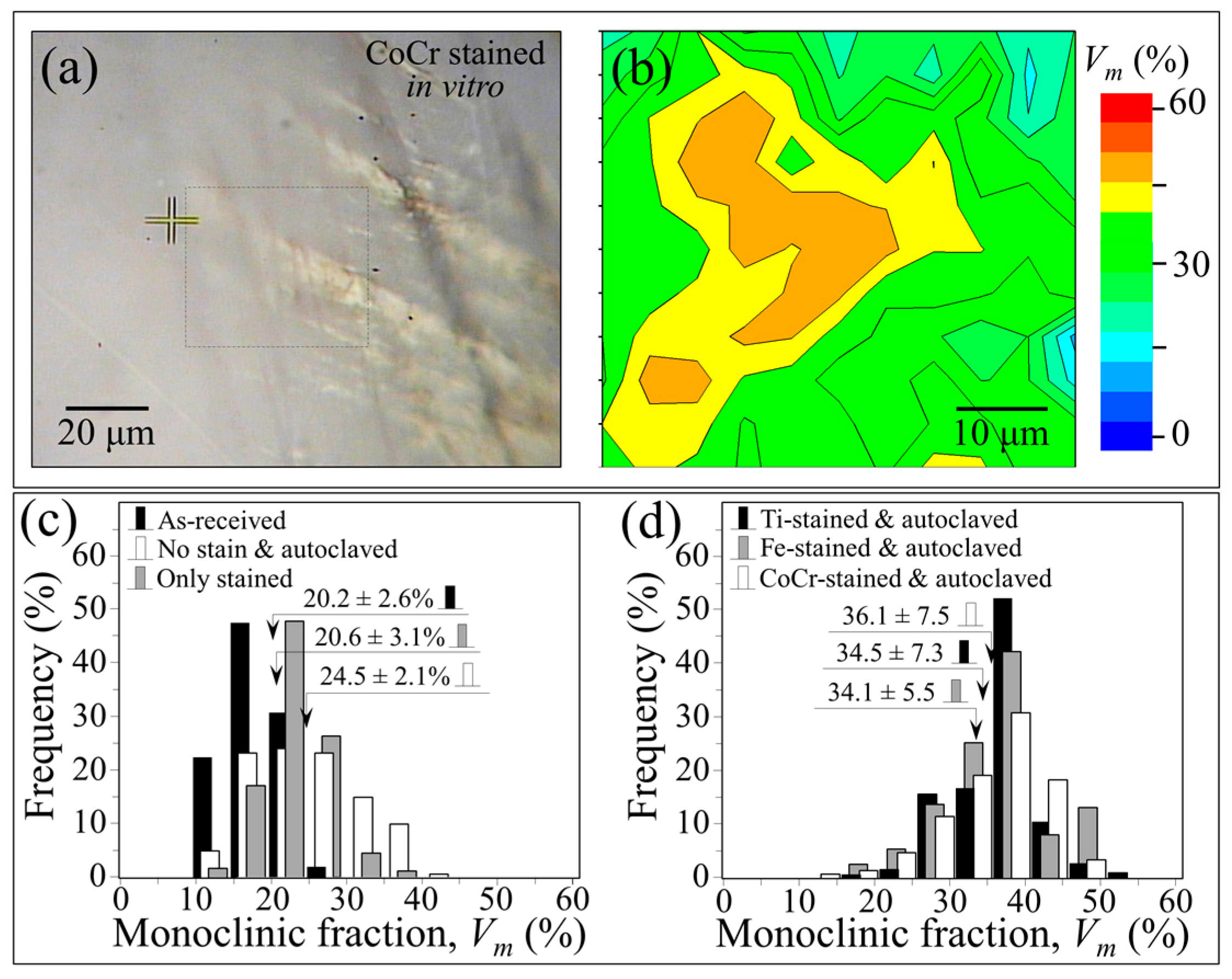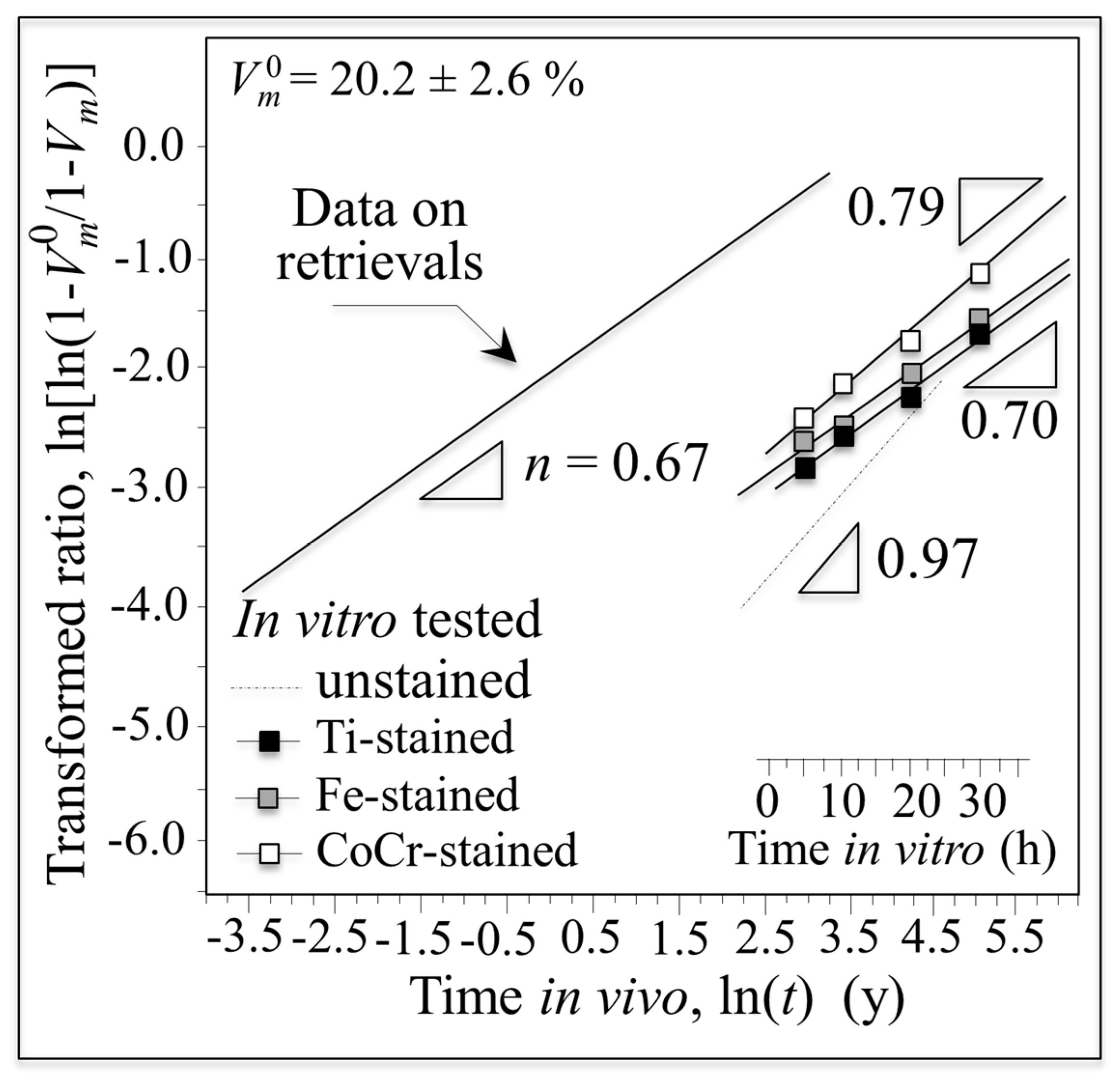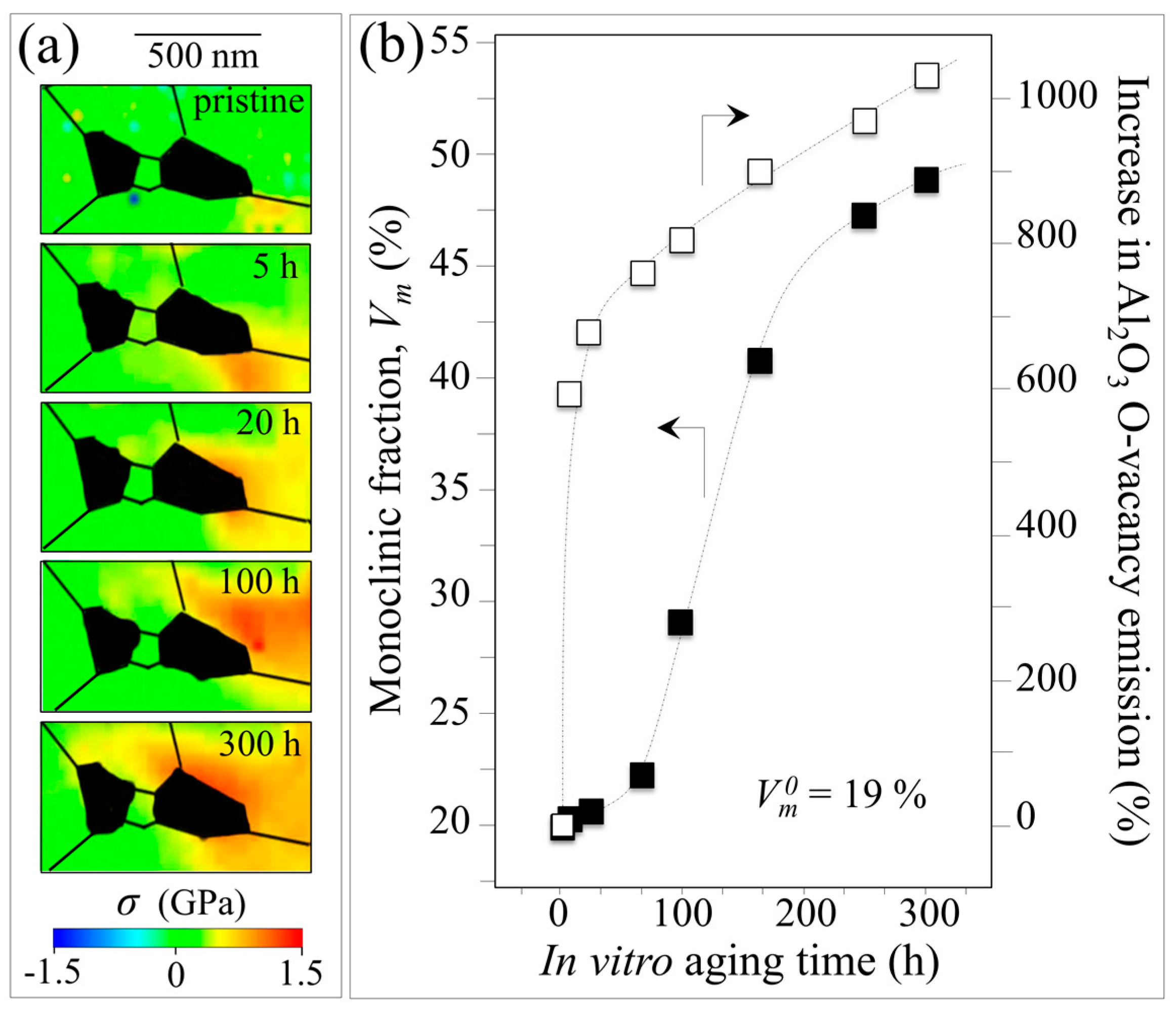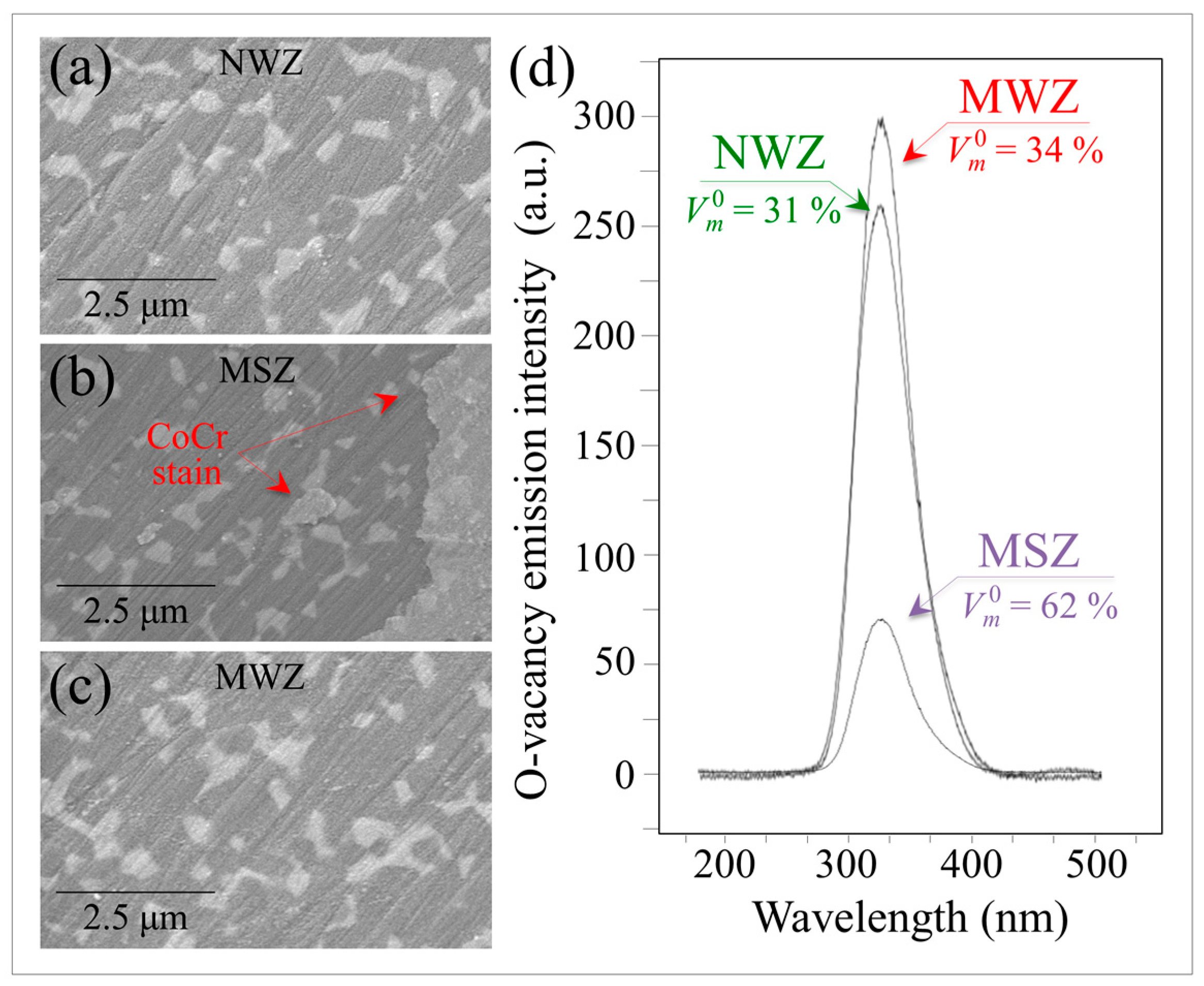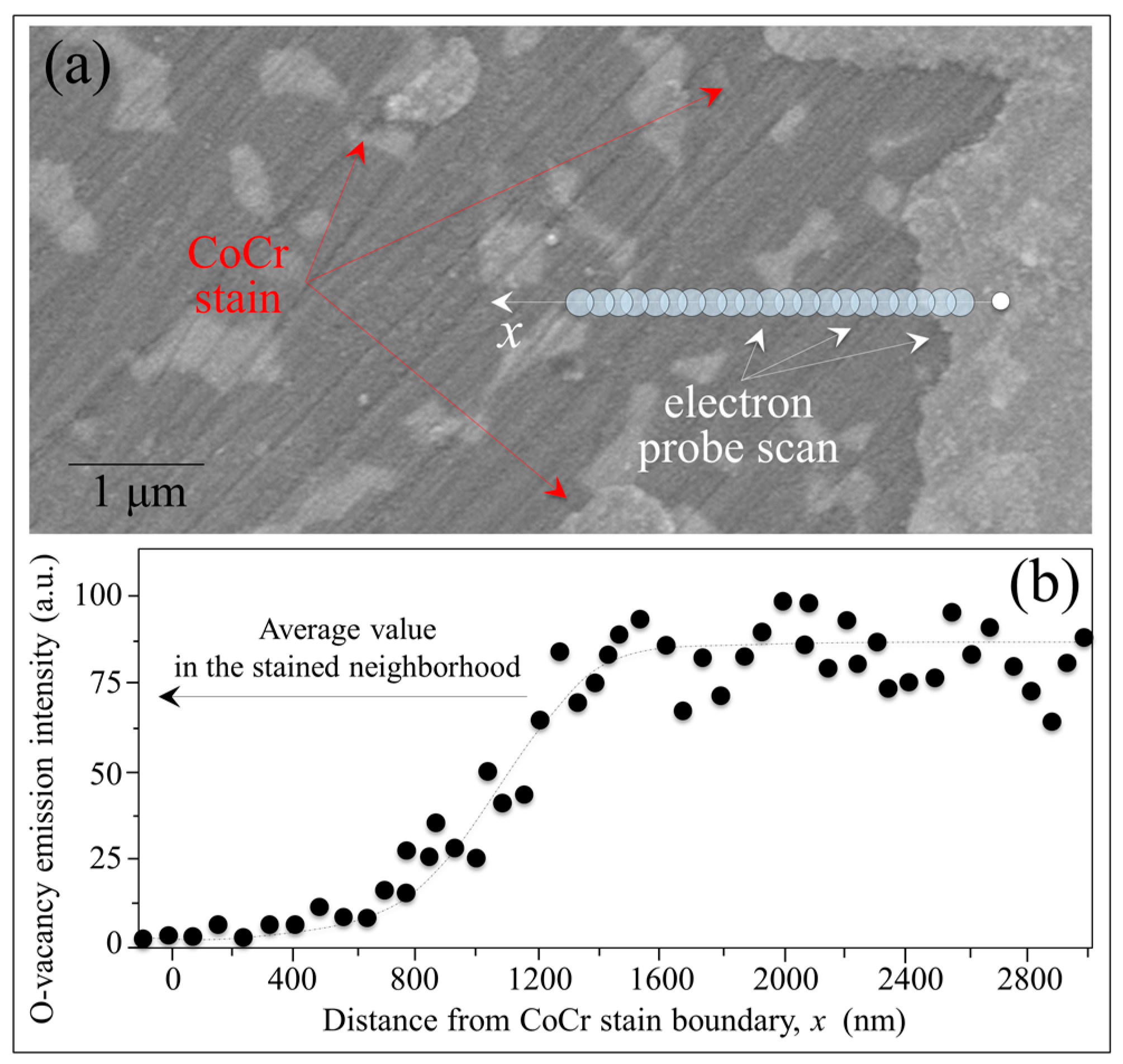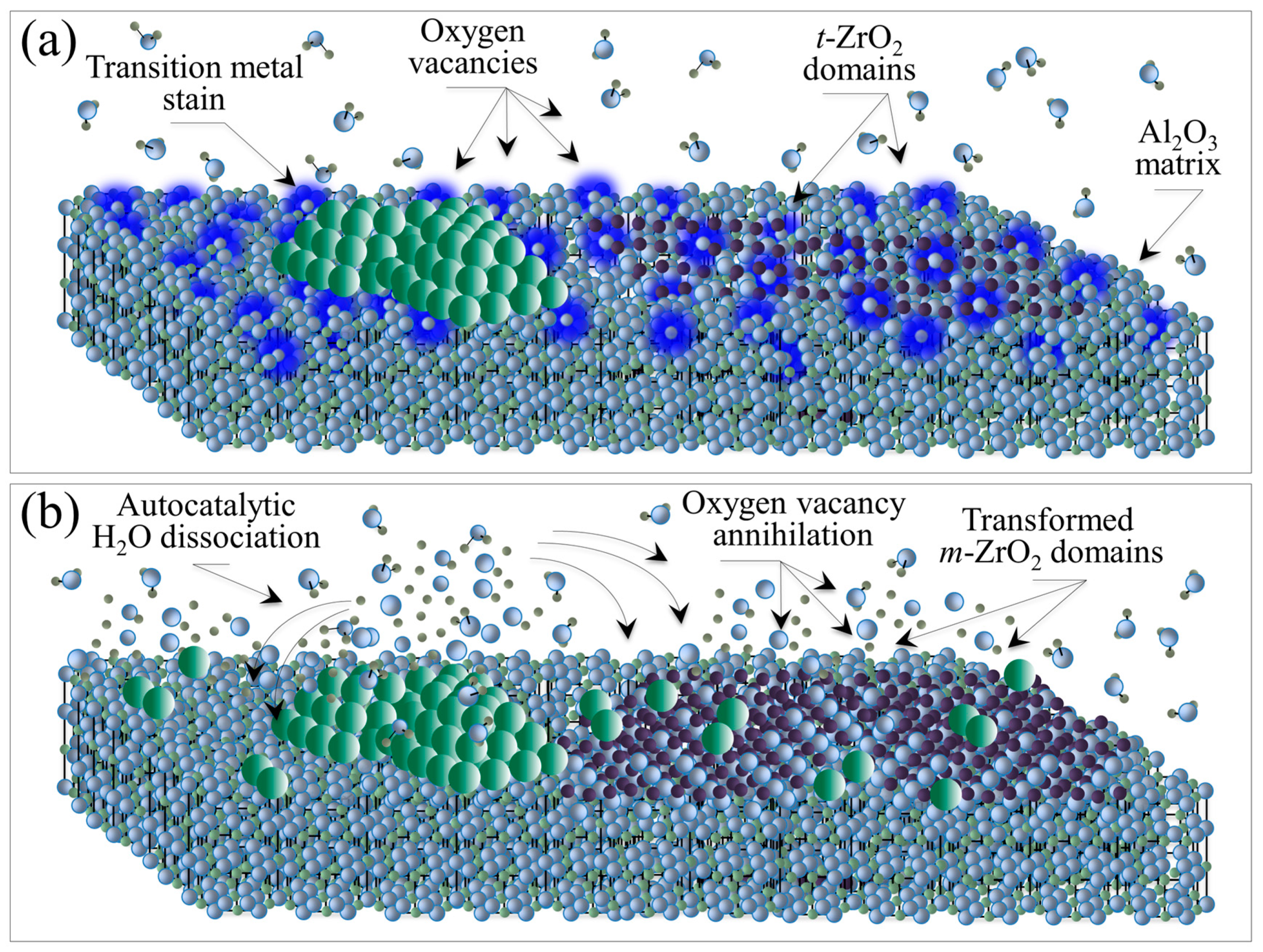3.1. Discrepancies between In Vitro and In Vivo Phase Stability
Data for retrieved and in vitro hydrothermal tested femoral heads are compared in
Figure 1 using a log–log plot with time on abscissa and the monoclinic transformation ratio on the vertical axis (i.e., ln(ln((1 −
Vm0)/(1 −
Vm))) vs. ln(
t);
Vm0 is the initial monoclinic phase fraction prior to hydrothermal aging). Since
Vm0 values for individual retrievals were unknown prior to their implantation, the average monoclinic fractions measured on the non-wear/non-contact zones were assumed to be
Vm0 values. In the simulated plot, in vitro data were converted to in vivo lifetimes in accordance with ASTM F2345-03 (i.e., 2.5 h of in vitro aging at 134 °C represents ~5 years in vivo at homeostatic temperature) [
16]. This standard is based on the prevailing theory governing the kinetics of the phase transformation known as the Mehl–Avrami–Johnson (MAJ) equation [
7,
21,
22,
23]. The linear dependence of the phase transformation ratio (vertical axis) allows the determination of the Avrami exponent,
n, according to the following relation [
21]:
where
b is a parameter that represents the temperature dependence of the aging effect,
t is the aging duration, and
n is a time exponent (which is independent of temperature). The
n exponent can be derived directly from the logarithmic form of Equation (1) by best-fitting of the linear regression line as those shown in
Figure 1. The
n value intrinsically reflects rates for both nucleation and growth of monoclinic ZrO
2 domains. Note here that wear caused by any abnormal activity, acidosis, and/or overloading due to abnormal body weight of the patients were not considered. These factors may result in a deviation of the obtained data from the linear plot. However, it is yet remarkable that a linear plot could be drawn with a reasonable approximation and a statistically larger number of investigated retrievals including other published data could increase the reliability of the plot. Therefore, when displayed on this log–log scale, ZTA retrieval data from different studies were also rationalized on the same plot regardless of the type of implant (i.e., CoC or CoP) [
10,
12]. Experimental data from previous studies on yttria-stabilized zirconia demonstrated that
n exponents ranged between 0.5 and 4 [
21,
22]. For
n values close to 4, the preponderant contributor to the transformation kinetics is the growth of pre-existing monoclinic nuclei (
Vm0); whereas small
n values are representative of high nucleation rates. Because the data for the in vitro simulated and in vivo retrieved ZTA samples of
Figure 1 have
n exponents in the low range (i.e.,
n = 0.67 (
R2 = 0.65) and 0.63 (
R2 = 0.58), respectively), the transformation kinetics for both types of ZTA materials are dominated by the formation of monoclinic nuclei. Moreover, an Avrami exponent of
n < 1 suggests that the overall growth mechanism is slow and the subsurface increase in the monoclinic phase is delayed [
21]. In spite of the observed consistency of the Avrami slopes of
Figure 1, there is a discrepancy between in vitro and in vivo plots. Utilizing the ASTM standard, the extrapolated in vitro simulations completely failed to predict the amount of transformation occurring in vivo by several orders of magnitude. The experimental data for the retrievals clearly conflict with the manufacturer’s statement: [
8] “the accelerated ageing was simulated by 5 h and 100 h treatment in autoclaving conditions which is equivalent to 10 years and 200 years (!) in vivo.” Indeed, the observed transformation rates in vivo were ~10
3 faster than predicted by ASTM standard (i.e., 1 h in vitro appears to correspond to ~18 h in vivo). These results suggest that in vitro low-temperature simulation studies on the aging of ZTA ceramics have serious limitations when extrapolated to in vivo conditions. Furthermore, the current ASTM standard is inadequate in predicting transformation lifetimes for the in vivo environment. Possible origins for the striking failure of the standard could be micromechanical and/or chemical; but both point to the possibility of extrinsic factors responsible for the phase transformation in vivo. These factors will be experimentally investigated and discussed in subsequent subsections.
Undoubtedly, the Al
2O
3 matrix within the ZTA microstructure is at least partly responsible for the small
n exponent. The transformation process is limited to isolated ZrO
2 grains due to the constraining effects of the surrounding Al
2O
3 matrix. Pecharromán et al. [
24] recommended an upper limit of 16 vol.% (~22 wt.%) for zirconia concentration in an alumina matrix in order to avoid subsurface spreading of monoclinic domains. This ZrO
2 concentration corresponds to the theoretical percolation threshold. In other words, when the Al
2O
3 content is below 74 vol.%, the material’s stability can abruptly deteriorate due to the statistical connectivity of adjacent ZrO
2 grains. Note that the ZrO
2 fraction in the studied ZTA femoral heads is exactly at the percolation limit. The compositional standard for zirconia-based ceramics, ISO 13356, allows an initial
m-ZrO
2 fraction of up to 20 vol.%. Because of this, CeramTec’s technical literature states that [
8]: “the specific composition of BIOLOX
®delta provides inherent protection against improper phase transformation.” However, this statement is at odds with the aforementioned scientific literature which demonstrated that ZrO
2 contents at or above the percolation limit are inherently unstable and risk accelerated surface and sub-surface transformation.
3.2. The Effect of the Initial Monoclinic Fraction
The large range of initial monoclinic fractions for BIOLOX
®delta components released through the years is provided in the histograms of
Figure 2a. These were collected on 32 ZTA as-received femoral heads manufactured during the decade 2005–2015. The histogram in the left-hand plot shows the percentage of heads and their average monoclinic phase fractions as a function of manufacturing date, while the right-hand histogram gives the statistical evolution of the monoclinic content after an autoclave cycle of 121 °C at adiabatic pressure. The left plot indicates that the BIOLOX
®delta femoral heads released to the market contained average surface
m-ZrO
2 phase fractions fluctuating between 10% and 55%. Note that there is a higher average fraction for heads manufactured on or before 2009. When average data are grouped according to manufacturing year, improved manufacturing control of the
m-ZrO
2 phase fraction is noted in successive years. Nevertheless, the data still indicate a broad distribution of surface monoclinic contents for the marketed heads. Autoclaving the heads in a hydrothermal environment increases the monoclinic polymorph as expected (i.e., in the range of 30%~65%) while currently narrowing the width of the statistical distribution. Although differences between sets of components from specific manufacturing years were generally reduced, there were still isolated instances of monoclinic contents of between 80% and 90%.
Figure 2b correlates the average size of the zirconia domains in the BIOLOX
®delta microstructure with their initial amounts of monoclinic fraction,
Vm0. The size of zirconia domains,
d, which was obtained by a random-line intercept method from scanning electron micrographs, fluctuated between 200 and 500 nm. Remarkably, the fraction of transformed zirconia in the as-received components,
Vm0, increased sharply with increasing domain size, but tended to saturate above 500 nm. The average size of the alumina grains (not shown) fluctuated between 500 and 800 nm. In other words, the observed increase in
Vm0 clearly corresponded to a coarsening of the ZTA microstructure. There are multiple potential reasons for microstructural coarsening in ZTA sintered bodies including variations in the particle size of the raw materials, thermal fluctuations during sintering, and the homogeneity of the sintering additives.
Monoclinic fractions for the retrievals and for in vitro hydrothermally treated heads at 134 °C as a function of time are shown in
Figure 3. While the tradition MAJ equation suggests only an additive role for the initial monoclinic content, it was noted that the transformation ratio appeared to also correlate with apparent activation energy. To rationalize this effect, the traditional MAJ equation was modified to show that the Avrami exponent,
n, has a dependence on the temperature. Rearranging from Equation (1) gives the following relation: [
25]
where
b0 is a material constant,
Q is the activation energy for phase transformation during environmental ageing,
R is the universal gas constant, and
T is the absolute temperature. Accordingly, the slope of a plot of
vs.
lnt at constant temperature becomes
n, while the slope of a plot of
vs.
is intrinsic activation energy. Note that the formalism of Equation (2) predicts the existence of an intrinsic value for the activation energy,
Q, but allows variations of the apparent activation energy value,
Qapp, since
n is also a function of temperature. The plots of
Figure 3, which give the phase-transformation ratio as a function of ln
t for components with different initial monoclinic ratios (i.e., different zirconia domain size; cf.
Figure 2b) at the constant temperature of 134 °C can now be rationalized according to their different Avrami slopes,
n. However, the dominant kinetic mechanism is still the nucleation rate of monoclinic domains (
n ≤ 1), but there is an increasing contribution from the growth of the formed nuclei as well.
When the plot is extrapolated to in vivo lifetimes according to ASTM F2345-03 and drawn vs. the in vivo recorded average dependence from
Figure 1, a role can clearly be envisaged for the dependence of transformation kinetics on
Vm0 (or
d). While this can partly explain the scatter of in vivo data in
Figure 1, it cannot fully justify the gap between in vitro and in vivo transformation kinetics. Accordingly, there appears to be an additional trigger(s) for the in vitro/in vivo experimental discrepancy.
3.3. The Stress Trigger
The effects of mechanical stress induced by in vivo wear, impact, or shock are not included in the standard in vitro simulation test. This may be one reason why simulated results are inadequate in predicting in vivo ZTA transformation kinetics. Perrichon et al. [
26] recently suggested an improved protocol for in vitro aging of metastable ceramics which included the effect of surface stresses in evaluating their hydrothermal stability. Their protocol certainly represents an improvement over the current standard, although it is not clear whether the presence of mechanical stress is the main trigger for enhanced in vivo transformation reported in
Figure 1. In order to shed light on the contribution of mechanical stress on the transformation kinetics, in vitro hydrothermal aging experiments using BIOLOX
®delta ZTA heads were repeated with 5 kgf Vickers indents applied to their as-received surfaces.
Figure 4 shows the results of these experiments. They were conducted on two individual ZTA heads whose microstructures consisted of ZrO
2 domains of different sizes and, accordingly, different initial amounts of monoclinic phase contents,
Vm0. These heads were subsequently autoclaved (cf. labels). Maps of their monoclinic fraction with increasing autoclave exposure (up to 100 h at 134 °C) clearly revealed an alteration of the phase-transformation kinetics. Zones around the imprints generally demonstrated accelerated transformation rates; and these alterations were clearly more pronounced on the component with the coarse microstructure and higher initial
Vm0.
Residual stress fields around the indentations were studied using protocols from previously published reports in order to quantify differences in transformation rates [
27,
28]. According to Yoffe’s theory [
29] (schematically shown in
Figure 5a), an indent introduces positive and negative residual stress fields in different zones on the material’s surface. Tensile stress fields are created due to the generation of small microcracks in the vicinity of the outside edges of the indent (i.e., hoop stresses on the order of few hundreds MPa) [
30,
31] and at the tip of the main radial microcracks propagated from the imprint corners (i.e., red areas in
Figure 5a). However, compressive radial stresses of several GPa remain within the imprint in areas close to the indentation edges (e.g., blue areas in
Figure 5a) and their magnitude decreases with increasing distance from the print center. In these areas, where plastic deformation is less pronounced, elastic residual stress fields can be measured [
27]. In non-transforming ceramics, the elastic residual stress fields obey Yoffe’s formalism to a high degree of precision [
27]. Because ZTA is prone to polymorphic transformation, the Yoffe stress is instantaneously altered by an overlapping stress field induced by the volume expansion associated with the transformation of the zirconia dispersoids [
28]. A comparison between the Raman maps in
Figure 4 and the schematic of
Figure 5a reveals that the zones under residual stress are tensile in nature. These tensile zones are transformed the most; and they will continue to transform with increasing autoclave time.
Plots are given in
Figure 5b of the phase-transformation parameter, ln(ln((1 −
Vm0)/(1 −
Vm))), in both tensile and compressive stress zones around the indents as a function of both autoclave time and extrapolated in vivo lifetime according to ASTM F2345-03. The related Avrami slopes,
n, are given in the inset. The transformation fractions were quite different for regions affected by tensile and compressive stresses; whereas the monoclinic fractions developed after autoclaving were significantly influenced by the initial monoclinic fraction,
Vm0 (i.e., higher
Vm0 resulted in a greater amount of
t→
m ZrO
2 transformation). On the one hand, tensile residual stresses greatly enhanced the transformation rate while generating a relatively high Avrami slope. On the other hand, the effect of compressive stresses was less significant in terms of enhanced transformation and resulted in lower Avrami exponents,
n, when compared to non-indented samples. In terms of nucleation and growth, it appears that nucleation controlled the surface transformation kinetics regardless of the nature of the residual stress. Tensile stresses accelerated the transformation kinetics with increased contributions from nuclei growth (i.e., a larger Avrami exponent); and compressive stresses slowed the transformation. Nuclei formation was predominant (as testified by a reduced Avrami slope) when compared to unstressed samples.
A comparison with the retrievals data (cf.
Figure 5b) suggests that tensile residual stresses in components with an initially high fraction of monoclinic phase may be a powerful trigger of the polymorphic transformation in vivo. However, tensile stresses alter the way in which polymorphic transformation proceeds, with enhanced contributions from nuclei growth (i.e., higher Avrami slope). In principle, tensile residual stresses justify the faster transformation rates observed in vivo with respect to the static hydrothermal stress in vitro. However, despite being larger in magnitude than the tensile ones, compressive stresses were less effective in raising the in vitro plot in
Figure 5b to the levels observed on retrievals. The key point is this: Independent of whether the heads came from CoC or CoP couples, they were absent of any damage or microcracks similarly induced on the indented samples. This finding is in line with previous reports [
12,
15]. In addition, hard-on-hard impingement or third-body wear usually introduce compressive rather than tensile stresses in ceramic couples [
32]. Moreover, it is not immediately obvious how the presence of a softer sliding counterpart in CoP couples could cause tensile residual stresses of the relatively high magnitude necessary to accelerate the polymorphic transformation. These arguments point to the possible presence of an additional trigger, perhaps of chemical nature, which is discussed in the next subsection.
3.4. The Chemical Trigger
A program of in toto Raman screening of some of the retrieved femoral heads was conducted in an effort to uncover possible additional triggers for the in vivo polymorphic transformation.
Figure 6a–d shows pictures of four selected retrievals and in toto Raman maps of their surfaces (cf. labels in the inset and
Table 1). Average Raman spectra for the main-wear zones (MWZ) and non-wear zones (NWZ) were compiled including bands for the tetragonal and monoclinic polymorphs, labeled as
t and
m in
Figure 6a–d, respectively. All of these samples showed metal contamination both in their MWZ and NWZ. The samples in
Figure 6a,b (No. 4 and No. 13 in
Table 1, respectively) had weak metal contamination with only small random patches and patterned coverage (small straight lines evenly distributed) along with a small solid patch on the upper hemisphere, respectively. The samples in
Figure 6c,d (No. 19 and No. 22 in
Table 1, respectively) both showed metal contamination with a number of random stripes, a large solid patch, and an extensive massive patch. The former two metal-stains are due to partial subluxation and impingement of the metal cup on the ceramic head. The later stain is a consequence of repeated prosthetic dislocations during surgical implantation. There were clear correlations between the topological stains and the monoclinic phase contents of these retrievals. This can be easily visualized in
Figure 6c,d. However, high amounts of
m-ZrO
2 also existed on apparently “clean” MWZ surfaces (i.e., non-stained, cf.
Figure 6a) as well as in NWZ areas with weak metal pits.
As shown in
Figure 7, concurrent scanning electron and Raman analyses of the NWZ (
Figure 7a) and MWZ (
Figure 7b) areas showed that the presence of microscopic metal debris greatly enhanced the transformation (cf. NWZ and MWZ in
Figure 7c,d). Note that there is a very low amount of wear in the NWZ (
Figure 7a) and MWZ (
Figure 7b) as evidenced by the presence of detectable machining lines on the ceramic surface. While it is possible that some retrievals may have already had high amounts of transformation prior to implantation due to their early year of manufacture (cf. labels for Nos. 4, 13, and 19 in
Figure 6), the preponderance of the evidence suggests that chemistry plays a critical role in the transformation. This conclusion is not only evident in the vicinity of heavy metal stains and patches, but also by the presence of diffuse metal ions.
In-depth confocal Raman measurements were collected on the samples shown in
Figure 6 in order to non-destructively trace the transformation profile into the head’s sub-surface.
Figure 8a–d shows selected maps for the in-depth transformation on the metal-stained MWZ, metal-stained NWZ (labeled as metal-stained zone, MSZ), and non-stained NWZ of Samples No. 4, 13, 19, and 22.
In general, there was a gradual decrease in monoclinic content with increasing depth, z. However, the MWZs experienced relatively higher monoclinic factions at greater z values as compared with their respective MSZs and NWZs. This finding suggests that it is the combination of mechanical stress and metal contamination enhanced by an initially higher amount of initial monoclinic content, Vm0 (i.e., the strong trigger) that leads to accelerated transformation (at least to 50 µm depth). Conversely, the amount of transformation for metal stained areas in the absence of surface stress is limited to a few sub-surface microns. Nevertheless, the presence of diffuse metal ions is apparently sufficient to significantly accelerate the transformation occurring at the ceramic’s surface. Because these analyses indicate that metal contamination (a common phenomenon in total hip arthroplasty) markedly affects surface metastability, an experimental in vitro program was designed and conducted to mechanistically understand and quantify the effects of this phenomenon.
Raman maps were collected at selected regions of as-received ZTA femoral heads before and after intentionally introducing different metal stains at room temperature. The metal stains were simply applied by gently rubbing the surfaces of the femoral heads with a metal rod analogous to how chalk is used on a blackboard. These same zones were then mapped again using the Raman probe after in vitro exposure for 24 h in water vapor at 121 °C under adiabatic pressure.
Figure 9a shows an optical micrograph of the surface of a CoCr-stained ZTA femoral head after this exposure. A Raman map obtained in the vicinity of the CoCr stain, which corresponds to the squared inset of
Figure 9a, is shown in
Figure 9b. The Raman map showed a relatively high amount of transformed
m-ZrO
2 adjacent to the metal stain (i.e., average value
Vmav = 36.1% ± 7.5% and maximum value
Vmmax = 49.6%); whereas the same sample showed negligible changes in its monoclinic fraction after staining but before autoclaving when compared with its pristine condition (i.e.,
Vmav = 20.6% ± 3.1% vs. 20.2% ± 2.6%;
Vmmax = 23.3% vs. 22.3%; cf. labels in the inset to
Figure 9c). Similar low
m-ZrO
2 values were found after autoclaving an unstained sample (
Figure 9c). These results demonstrate that enhanced destabilization is mainly due to chemical effects associated with the metallic stains and not merely the result of either hydrothermal attack or mechanical stress.
Raman maps of
m-ZrO
2 contents were acquired for all types of stains (i.e., CoCr, Fe, and Ti) at exactly the same locations before and after staining, and again after autoclaving. Statistical histograms comparing monoclinic fractions after autoclaving are shown in
Figure 9d. Identical trends were found for all of the metallic stains, leading to the following conclusions: (i) the mechanical action of room temperature staining introduced negligible amounts of polymorphic transformation in the stained zone; (ii) a short term autoclave treatment was sufficient to increase the amount of
m-ZrO
2 by 50% or more in the stained areas when compared to the as-received controls; and (iii) areas far away from the stains showed minimally higher amounts of
m-ZrO
2 after short-term autoclaving as compared to pristine samples.
After acquiring a complete set of in vitro data at 134 °C, the exercise of plotting the phase-transformation parameter, ln(ln((1 −
Vm0)/(1 −
Vm))), in the metal stained zones as a function of both time in autoclave and ln
t was repeated (
Figure 10). In vitro conditions were extrapolated to in vivo lifetimes according to ASTM F2345-03. Avrami slopes,
n, given in the inset, were similar for all the types of investigated stains and close to those recorded for retrievals. The in vitro plots for the transformed fraction on the metal-stained samples demonstrated accelerated transformation kinetics and higher Avrami slopes when compared to unstained reference sample (i.e., broken line in the plot). This indicates that metal stains significantly impact the
m-ZrO
2 nucleation rate, with nuclei multiplying faster in the vicinity of the stained areas.
3.5. Polymorphic Transformation and Its Triggers at the Molecular Scale
The previous subsections reviewed three factors affecting the polymorphic phase transformation in ZTA femoral heads (i.e., the initial
m-ZrO
2 content, surface stress, and metallic stains). Each of these is inexorably connected to the hydrothermal effect as well. Individually or in combination, they trigger destabilization of the
t-ZrO
2 phase. Mechanistically, the size of the zirconia domains regulates the initial amount of the monoclinic phase, while tensile stresses enhance existing nuclei growth, and metal stains accelerate nucleation of
m-ZrO
2 sites. There concomitant contributions resulted in the phenomenological plot shown in
Figure 1. However, tensile stresses exhibited a fundamentally different kinetic behavior (i.e., an enhanced Avrami slope) when compared to data from retrievals. Moreover, the development of local residual stresses in the ZTA microstructure should be a
consequence of the polymorphic transformation rather than a prerequisite. This assertion can be experimentally justified by observing residual stresses using CL analyses for off-stoichiometrically drifting sites [
33,
34,
35]. This technique involves probing the sample using a low-voltage electron beam with nanometer-scale resolution (i.e., spatial resolution two orders of magnitude higher than the Raman probe) to concurrently reveal local off-stoichiometry and lattice stresses in alumina-based bioceramics. At the molecular scale, local stoichiometry and stress are linked and can be analyzed by monitoring the luminescence emission for oxygen vacancies,
Vo, in the Al
2O
3 lattice. The
Vo sites emit a doublet, which corresponds to oxygen vacancy sites charged with one or two electrons [
36]. The photon intensity emitted by electron-irradiated samples (i.e., the area subtended by the
Vo doublet) is proportional to the number of defective sites lying within the probe (i.e., stronger intensities correlate to greater surface off-stoichiometry). The wavelength of the emission relates the stress field to the vacancy concentration; and this has been precisely calibrated using both single-crystal sapphire and polycrystalline alumina samples [
31,
32,
33].
Figure 11a shows a CL assessment of the stress field in the vicinity of metastable zirconia domains in pristine BIOLOX
®delta ZTA femoral heads and after they have been subjected to increasing exposures in the autoclave at 121 °C (i.e., for 5~300 h). The resulting CL maps for
Vo sites clearly show an increase in tensile residual stress within the alumina matrix surrounding the zirconia domains (emphasized in black color). The plots shown in
Figure 11b were generated by concurrently observing the off-stoichiometric drift within the alumina matrix (i.e., the intensity of the CL emission from
Vo sites) and the polymorphic transformation (i.e., by Raman spectroscopy).
These results reveal that the oxygen vacancy concentration within the alumina lattice sharply increases with autoclave exposure and saturates after about 50 h (cf., an abrupt change in the slope of the oxygen-vacancy curve of
Figure 11b). The threshold of 50 h exposure also corresponds to a steep rise in
m-ZrO
2 suggesting a link between the off-stoichiometry of the alumina lattice and the destabilization of zirconia dispersoids. Oxygen-vacancy formation occurs due to dehydroxylation of the alumina surface, which in turn is caused by thermal activation of the O-H bonds [
37,
38]. Note that this phenomenon is peculiar to the alumina lattice. Conversely, the zirconia hydroxylated surface is quite stable; it hardly loses oxygen to form new vacancy sites. The zirconia dispersoids are partially stabilized in their tetragonal polymorph by doping with sub-valent yttrium (Y
3+), which substitutes for zirconium (Zr
4+) in the lattice. This substitution creates oxygen vacancies in order to maintain charge balance in the lattice; and it is the main reason why the tetragonal polymorph can be partially stabilized at room temperature [
39]. The data in
Figure 11 suggest that alumina plays a self-sacrificing role in protecting the metastable
t-ZrO
2 domains from prematurely transforming to their stable
m-ZrO
2 form. However, as soon as dehydroxylation of the alumina lattice slows (i.e., after ~50 h exposure), pre-existing oxygen vacancies in the tetragonal zirconia lattice are progressively annihilated which triggers their transformation. Additionally, the observed tensile stress in the alumina lattice actually serves to counterbalance the compressive stress of the constrained zirconia domains after their volumetric expansion into the monoclinic polymorph.
Now, with regards to the molecular scale interaction of metallic stains, it should be noted that the chemical elements comprising all metal stains in hip arthroplasty (i.e., Ti, Fe, Co and Cr) belong to period 4 of the Table of Elements (i.e., the first 3
d orbital). Their ability to adopt multiple oxidation states and to form complexes through utilization of 3
d and 4
s electrons is well known [
40]. These peculiar characteristics increase the concentration of reactants at their surfaces while concurrently weakening bonds in catalytically reacting molecules.
Figure 12a–c shows scanning electron micrographs from the NWZ, MSZ, and MWZ of a CoCr metal-contaminated BIOLOX
®delta retrieval, respectively. This head was in vivo only for a short time against a polyethylene liner.
In comparing the three micrographs, note that there is no significant wear damage or other signs of mechanical interaction at the ZTA’s surface. Machining lines are equally observed in each micrograph. Although the different zones appear indistinguishable except for the presence of the CoCr stain in the MSZ (cf. arrows in
Figure 12b), their monoclinic contents clearly differ (cf. labels in the inset to
Figure 12d). The MSZ area contained a twofold higher local amount of
m-ZrO
2 as compared to both the MWZ and NWZ. The MWZ showed a slightly higher amount of the monoclinic phase when compared to the NWZ. These observations suggest that the driving force for the polymorphic transformation is predominantly chemical in nature. It is accelerated by the presence of a transition metal, although possibly exacerbated by enhanced frictional effects. Monitoring of the oxygen vacancy population by CL in different Al
2O
3 zones revealed that the highest concentration was in the MWZ. The NWZ also exhibited some off-stoichiometry drift, but the Al
2O
3 lattice in the MSZ was close to stoichiometric. The average CL emissions for
VO in different zones of the retrieval are shown in
Figure 12d. These data suggest that the CoCr metal stain effectively impedes dehydroxylation and oxygen-vacancy formation in the Al
2O
3 lattice. Additional evidence that metal stains annihilate oxygen vacancies is provided by the CL line scan of
Figure 13a. This graph provides CL results as a function of distance,
x, from a CoCr-contaminated zone for a hydrothermally-treated ZTA head. The
Vo emission profile (
Figure 13b) essentially showed the annihilation of oxygen off-stoichiometry for a distance
x ~ 400 nm. This was followed by its exponential rise to a saturated level similar to the MSZ
Vo concentration shown in
Figure 12b.
When water from the hydrothermal environment binds to transition metal molecules, several proton-coupled electron-transfer events occur that oxidize the metal-water complex. Electrons are stripped away and participate in the process of water reduction. All these metallic elements present the same basic characteristics although they exhibit different levels of efficiency in splitting water. The half-filled
d-orbitals facilitate both the binding of water and the release of molecular oxygen and hydrogen. It is also known that chromium atoms can easily diffuse along the Al
2O
3 surface, moving from one three-coordinated Al site to another since their activation energy for self-diffusion is lower than for Al atoms [
41]. Chromium ions form strong Cr-H bonds with water molecules. They trigger autocatalytic dissociation of water due to splitting of the polar molecule to form Cr-H bonds. This behavior is consistent with
Vo annihilation in the Al
2O
3 lattice, both for in vivo and in vitro CoCr stains (cf. CL spectrum in
Figure 12b and the disappearance of emissions from oxygen-vacant sites in the profile of
Figure 13b), It is therefore proposed that Cr
3+ separates from the stain and enters Al
3+ sites close to oxygen vacancies while free oxygen from the split water molecules fills pre-existing vacancies. Concurrently, strong Cr-H bonds form with available hydrogen to impede further surface dehydroxylation. Accordingly, new oxygen vacancies form in the Al(Cr)O
3 lattice close to the stained area. In this stoichiometrically “locked” environment, the propensity of the Al
2O
3 lattice to release oxygen and form stable water molecules or incorporate free oxygen is conspicuously eliminated. This effect fully exposes the metastable
t-ZrO
2 lattice to free oxygen absorption, resulting in its destabilization and transformation to the
m-ZrO
2 polymorph.
It is also well known that iron oxide is an effective catalyst for the oxidation of water; and its catalytic efficiency increases 50~80 times in the presence of alumina. This enhancement stems from the interaction of Fe with Al. Their combination alters the surface redox processes favoring the production of strong oxidants during water decomposition [
42]. On the ZTA surface, iron ions in contact with the alumina matrix favor a radical water decomposition mechanism (series of 1e
− transfer steps) over a non-radical mechanisms (2e
− transfer step), leading to enhanced
•OH production. Lim et al. [
43] postulated that alumina (a Lewis acid) expedites the reduction of Fe (III) in presence of water because it attracts electrons from iron thereby raising the oxidation potential of the Fe (III) center.
With regards to the titanium stain, it readily oxidizes to TiO
2 when exposed to a hydrothermal environment. The resulting oxide layer has an ability to form electron-hole pairs. Electrons are released at the material’s surface and are scavenged by molecular oxygen producing superoxide radicals. While this reaction is competitive with electron-hole recombination, it also initiates a free-radical chain by forming hydroxyl radicals,
•OH [
44,
45].
CL studies in the vicinity of Fe (from stainless steel) and Ti contaminants confirmed the annihilation of
Vo sites. However, there were differences in the CL spectra for these metallic stains.
Figure 14 compares CL spectra collected for Fe-(a) and Ti-contaminated (b) ZTA surfaces after an in vitro hydrothermal cycle of 200 h. The CL spectra shown in
Figure 14c,d were collected at the spots depicted in the insets of
Figure 14a,b, respectively. The results for iron suggest that a fraction of Fe
3+ ions penetrated the zirconia lattice substitutional for Zr
4+. This was confirmed by a sub-band emitted at ~455 nm in the CL spectrum shown in
Figure 14c. Conversely, there were no CL bands in the Ti-contaminated spectra that suggested Ti
4+ substitution into the ZrO
2 lattice (cf.
Figure 14d). The CL spectra from both Fe- and Ti-contaminated ZTA presented similarly weak emissions from oxygen vacancies in the Al
2O
3 lattice, which confirmed the process of vacancy annihilation described above for CoCr contamination. In principle, dilute amounts of sub-valent Fe
3+ substitutational located on Zr
4+ sites could generate vacancies and trigger destabilization of the tetragonal lattice [
46]. However, the enhanced kinetics detected by Raman spectroscopy suggests that this phenomenon did not delay the onset of the polymorphic transformation.
Despite having valences and ionic radii smaller than Zr
3+, neither Ti, nor Co or Cr affected the CL spectrum of ZrO
2, thereby ruling out any effect of frictionally induced mechanical alloying. In other words, a reduced concentration of oxygen vacancies in the ZrO
2 lattice was the key factor in the enhanced transformation kinetics. A schematic molecular model for the surface destabilization of ZTA contaminated with transition metals under frictionally loading within a hydrothermal environment is shown in
Figure 15.
In summary, the proposed new model for ZTA destabilization is based on metallic contamination at the composite’s surface and oxygen vacancies in both its alumina (i.e., dehydroxylation) [
47] and zirconia (i.e., yttria doping) [
48] lattices (
Figure 15a). There are three successive off-stoichiometry events (
Figure 15b): (i) autocatalytic dissociation of water at the metal surface; (ii) oxygen vacancy annihilation in the Al
2O
3 matrix until exhaustion; and (iii) oxygen vacancy annihilation in the
t-ZrO
2 domains followed by their transformation into
m-ZrO
2. All transition metals that frequently contaminate ZTA femoral heads in vivo detrimentally contribute to its surface destabilization. The contamination process, which induces off-stoichiometric drifts at the ZTA surface, is mainly chemically driven but enhanced by frictional effects and related surface charges. This new model explains the accelerated transformation kinetics; and it is in agreement with recently published X-ray photoemission spectroscopy data [
49]. A quantitative expression to replace the traditionally used MAJ [
7,
21,
22,
23] equation has been developed and its derivation is provided in a separate publication [
25].
